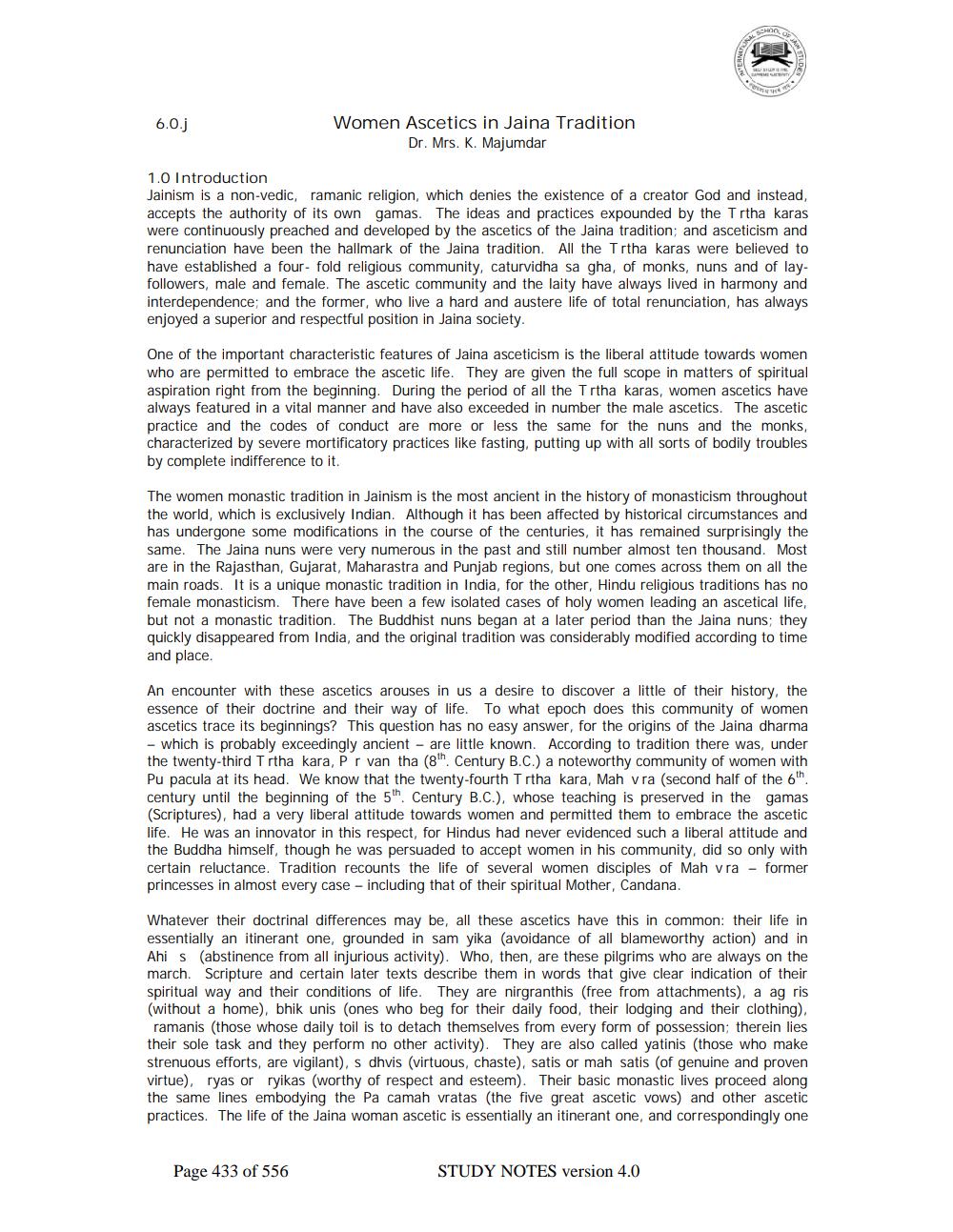________________
6.0.j
Women Ascetics in Jaina Tradition
Dr. Mrs. K. Majumdar
1.0 Introduction Jainism is a non-vedic, ramanic religion, which denies the existence of a creator God and instead, accepts the authority of its own gamas. The ideas and practices expounded by the Trtha karas were continuously preached and developed by the ascetics of the Jaina tradition; and asceticism and renunciation have been the hallmark of the Jaina tradition. All the Trtha karas were believed to have established a four- fold religious community, caturvidha sa gha, of monks, nuns and of layfollowers, male and female. The ascetic community and the laity have always lived in harmony and interdependence; and the former, who live a hard and austere life of total renunciation, has always enjoyed a superior and respectful position in Jaina society.
One of the important characteristic features of Jaina asceticism is the liberal attitude towards women who are permitted to embrace the ascetic life. They are given the full scope in matters of spiritual aspiration right from the beginning. During the period of all the T rtha karas, women ascetics have always featured in a vital manner and have also exceeded in number the male ascetics. The ascetic practice and the codes of conduct are more or less the same for the nuns and the monks, characterized by severe mortificatory practices like fasting, putting up with all sorts of bodily troubles by complete indifference to it.
The women monastic tradition in Jainism is the most ancient in the history of monasticism throughout the world, which is exclusively Indian. Although it has been affected by historical circumstances and has undergone some modifications in the course of the centuries, it has remained surprisingly the same. The Jaina nuns were very numerous in the past and still number almost ten thousand. Most are in the Rajasthan, Gujarat, Maharastra and Punjab regions, but one comes across them on all the main roads. It is a unique monastic tradition in India, for the other, Hindu religious traditions has no female monasticism. There have been a few isolated cases of holy women leading an ascetical life, but not a monastic tradition. The Buddhist nuns began at a later period than the Jaina nuns; they quickly disappeared from India, and the original tradition was considerably modified according to time and place
An encounter with these ascetics arouses in us a desire to discover a little of their history, the essence of their doctrine and their way of life. To what epoch does this community of women ascetics trace its beginnings? This question has no easy answer, for the origins of the Jaina dharma - which is probably exceedingly ancient - are little known. According to tradition there was, under the twenty-third Trtha kara, P r van tha (8th Century B.C.) a noteworthy community of women with Pu pacula at its head. We know that the twenty-fourth Trtha kara, Mah vra (second half of the 6th, century until the beginning of the 5th Century B.C.), whose teaching is preserved in the gamas (Scriptures), had a very liberal attitude towards women and permitted them to embrace the ascetic life. He was an innovator in this respect, for Hindus had never evidenced such a liberal attitude and the Buddha himself, though he was persuaded to accept women in his community, did so only with certain reluctance. Tradition recounts the life of several women disciples of Mah vra - former princesses in almost every case - including that of their spiritual Mother, Candana.
Whatever their doctrinal differences may be, all these ascetics have this in common: their life in essentially an itinerant one, grounded in sam yika (avoidance of all blameworthy action) and in Ahis (abstinence from all injurious activity). Who, then, are these pilgrims who are always on the march. Scripture and certain later texts describe them in words that give clear indication of their spiritual way and their conditions of life. They are nirgranthis (free from attachments), a ag ris (without a home), bhik unis (ones who beg for their daily food, their lodging and their clothing),
ramanis (those whose daily toil is to detach themselves from every form of possession; therein lies their sole task and they perform no other activity). They are also called yatinis (those who make strenuous efforts, are vigilant), s dhvis (virtuous, chaste), satis or mah satis (of genuine and proven virtue), ryas or ryikas (worthy of respect and esteem). Their basic monastic lives proceed along the same lines embodying the Pa camah vratas (the five great ascetic vows) and other ascetic practices. The life of the Jaina woman ascetic is essentially an itinerant one, and correspondingly one
Page 433 of 556
STUDY NOTES version 4.0




